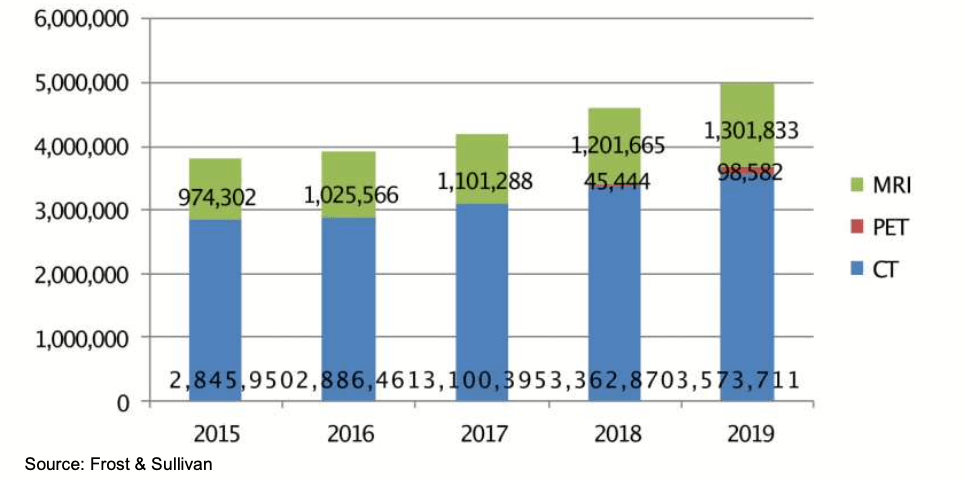RedLeaf: Singular has a sweet slice of the global VR, AI medical imaging pie

The global medical imaging market valued at a massive US$2.4 billion. Pic: Getty
Medtech Singular Health Group uses emerging technologies like AI, VR and Blockchain to develop its medical imaging products – and RedLeaf Securities reckons its onto something.
RedLeaf has rated the company at speculative buy with a valuation of $0.46 from its share price of $0.23.
“[The company] offers investors attractive exposure to the growing utilization of emerging technologies – such as VR, AI, Blockchain and metal 3D printing – in healthcare processes to improve patient outcomes through targeted bespoke medical technologies,” RedLeaf said.
Emerging technologies and M&A opportunities
Singular Health Group’s (ASX:SHG) core product – 3Dicom Surgical – is part of the company’s construction of a vertically integrated platform – spanning ‘Scan to Surgery’.
“This will take the patient from initial diagnostic scans through to the delivery of patient specific implants in the operating theatre,” RedLeaf says.
Plus, SHG’s 2021 acquisition of ‘Virtual Surgical Planning’ and an investment in a medical 3D printing facility in Melbourne forms an end-to-end surgical planning process that RedLeaf says will, “not only become a competitive advantage for the company and result in high operating margins but also provide bolt-on M&A opportunities.”
Global imaging market valued at a whopping US$2.4 billion
RedLeaf flagged that, given the rising global life expectancy and concurrently ageing populations, worldwide healthcare is experiencing strong growth and massive demand.
The global medical imaging market is valued at US$2.4B and growing at a CAGR of 8.18%, the medical AI market expected to grow at a CAGR of 30.4% and medical 3D printing at a CAGR of 16.3%.
And this momentum is expected to grow with the roll out of key elements of the metaverse and as multiple patient-specific surgeries become common-place throughout a patient’s lifespans.
AI is medicine
“In Australia alone there being almost 5 million scans per annum, conservative calculations mean that there are ~750 million images/slices to be analysed which AI can do much faster than humans without getting tired and being able to look for multiple diseases at the same time,” RedLeaf says.
“SHG’s software will ultimately allow radiologists and medical practitioners to run multiple AI models on the scans they load, convert 2D CT scans into interactive 3D models and even 3D printed bio- models, it positions the platform to capture these exciting trends.”
Moreover, it turns out people love looking at their scans – and using SHG’s 3DicomViewer, medical professionals can share images with annotations and reassuring descriptions/resources with patients to view in 3D on their mobiles, tablets, desktop computers and even in virtual reality.

VR is likely to see high adoption rates
In 2018, it was estimated that some 3 – 5% of clinicians in the U.S. were using VR in clinical applications.
And RedLeaf says there are now 8 million medical professionals globally that are earmarked as potential users of VR/AR technology – with 3.4 million of these expected to be users by 2025.
“We would highlight Virtual Reality (VR) as one emerging technology which is likely to see its adoption rates significantly increase over the coming years, despite VR technology being around for decades,” they said.
“We believe VR is still well below mainstream adoption. According to Gartner, VR adoption is at the same stage smartphones were in 2008.
“According to estimates, the healthcare VR market size globally is expected to reach US$5.1bn versus US$1.2bn in 2020.”
What do Bitcoin mining and gaming have to do with it?
Over the past two years the company has eliminated the requirement for bespoke hardware to be used to perform the 2D to 3D volume rendering, which has reduced capital expenditure from ~$5,000 to just $500 for a standalone VR headset and eliminated capital expenditure for mobile and desktop 3D volume rendering as users can use their own devices.
“This evolution has been aided through two key contributors to the development of high-powered graphics processing units (GPUs) and wireless, off-the-shelf VR headsets – Bitcoin mining and gaming,” RedLeaf said.
Essentially, Bitcoin mining has provided the consumer demand and economies of scale for GPUs in consumer-grade computers to be more powerful which allows SHG’s software to render medical images on the device.
Last year the company launched its Medical File Transfer Protocol (MFTP) which allows increased engagement between patients and health professionals by securely sharing medical imaging and design files – and it uses private blockchain infrastructure to record a distributed, immutable ledger of all transactions for a full audit trial while providing anonymity to users.
Leveraging the Metaverse
RedLeaf also said that gaming and the investments made by Meta Platforms into the Metaverse since the acquisition of Oculus (the VR headset company) in 2014, has led to advancements in headset graphics, collaborative VR experiences and wireless headsets.
“The distribution of Oculus’ Quest 2 wireless VR headset internationally via Amazon allows SHG to leverage this third-party distribution network and focus on developing, installing, and maintaining the software,” they said.
And because SHG’s product is built on the Unity platform – which is basically a game development platform – the product works across different devices and Windows and MacOS compared to other programs which are custom-coded to only work on Windows or MacOS.
This article was developed in collaboration with Singular Health Group Limited, a Stockhead advertiser at the time of publishing.
This article does not constitute financial product advice. You should consider obtaining independent advice before making any financial decisions.
Related Topics

UNLOCK INSIGHTS
Discover the untold stories of emerging ASX stocks.
Daily news and expert analysis, it's free to subscribe.
By proceeding, you confirm you understand that we handle personal information in accordance with our Privacy Policy.








